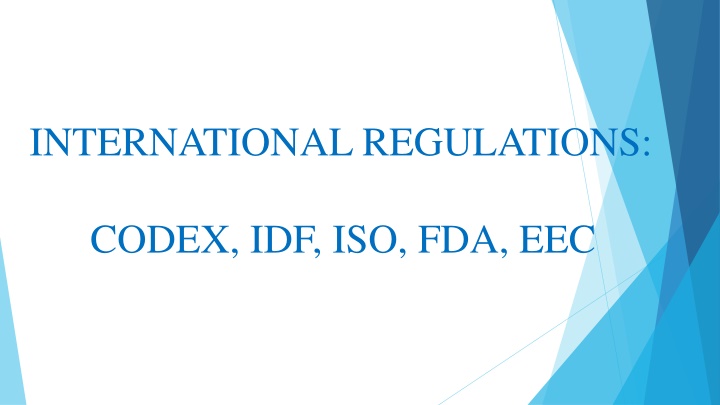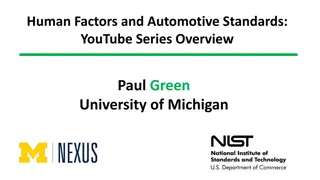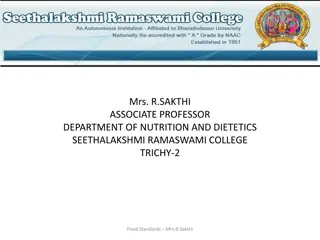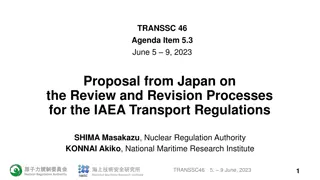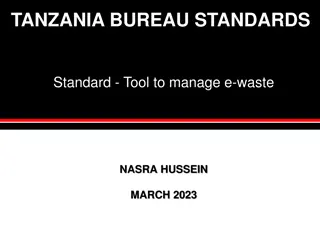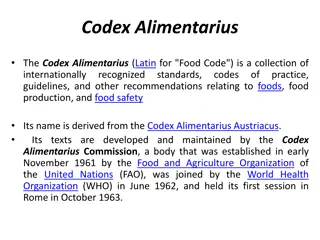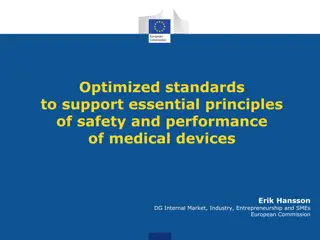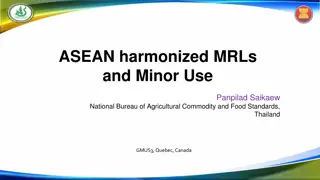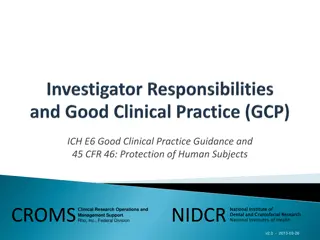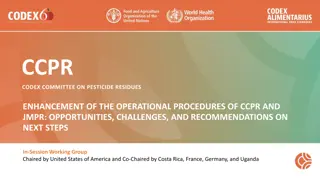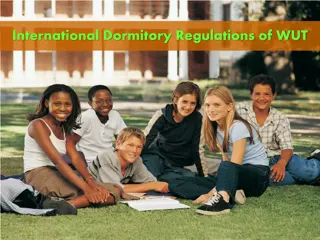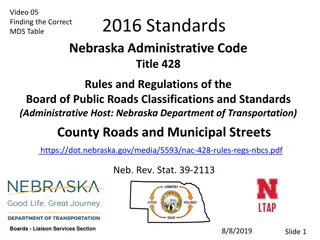International Regulations: Codex Alimentarius & IDF Standards
International regulations play a crucial role in ensuring food safety and fair trade practices. The Codex Alimentarius Commission establishes standards to protect consumer health, while the International Dairy Federation focuses on milk and dairy product analysis methods. These regulations cover various aspects such as food labeling, additives, contaminants, hygiene, and more. Adoption of these standards is essential for health authorities, government officials, manufacturers, scientists, and consumer advocates to uphold food safety measures.
Download Presentation

Please find below an Image/Link to download the presentation.
The content on the website is provided AS IS for your information and personal use only. It may not be sold, licensed, or shared on other websites without obtaining consent from the author.If you encounter any issues during the download, it is possible that the publisher has removed the file from their server.
You are allowed to download the files provided on this website for personal or commercial use, subject to the condition that they are used lawfully. All files are the property of their respective owners.
The content on the website is provided AS IS for your information and personal use only. It may not be sold, licensed, or shared on other websites without obtaining consent from the author.
E N D
Presentation Transcript
INTERNATIONAL REGULATIONS: CODEX, IDF, ISO, FDA, EEC
Codex Alimentarius Commission (CAC) The FAO and the WHO jointly established the Codex Alimentarius Commission (CAC) in 1962 to => implement the joint FAO/WHO food Standards Programme. Aim of the commission is to => protect the health of consumers by ensuring observance of fair practices in food trade. It promotes co-ordination of work on formulation of food standards undertaken by international governmental and non-governmental organizations.
It shall be responsible for => making proposals to, and shall be consulted by, the Directors-General of the FAO and the WHO on => all matters pertaining to implementation of the joint FAO/WHO Food Standards Programme. In addition to commodity standards, Codex Alimentarius includes => general standards, which have across-the-board application to all foods and are not product-specific.
There are general standards or recommendations for: Food labeling; Food additives; Contaminants; Methods of analysis and sampling; Food hygiene; Nutrition and foods for special dietary uses; Food import and export inspection and certification systems; Residues of veterinary drugs in foods; Pesticide residues in foods.
Most standards take a number of years to develop. Once adopted by the Commission, a Codex standard is added to the Codex Alimentarius. The Codex Alimentarius has become customary for => health authorities, government food control officials, manufacturers, scientists and consumer advocates to ask first of all: What does the Codex Alimentarius have to say? Adoption of HACCP standards, formulated by CAC, under the sanitary and phytosanitary (SPC) measures has made the HACCP system an instrument of food safety. It has become incumbent on signatory countries of the SPC agreement to implement these standards.
International Dairy Federation (IDF) IDF publishes jointly with the ISO, standard method of sampling and analysis of milk and milk products. Work Areas of IDF
International Organization for Standardization (ISO) ISO is a network of the national standards institutes of 158 countries => one member per country, with a Central Secretariat in Geneva, Switzerland, that coordinates the system. Nongovernmental organization that forms => a bridge between the public and private sectors. World's largest developer and publisher of International Standards. It enables a consensus to be reached on solutions that meet both the requirements of business and the broader needs of society.
"International Organization for Standardization" would have different acronyms in different languages e.g. "IOS" in English, "OIN" in French (Organisation internationale de normalisation). Its founders decided to give it also a short, all-purpose name. They chose "ISO", derived from the Greek isos, meaning "equal". Whatever the country, whatever the language, the short form of the organization's name is always ISO.
Characteristics of ISO standards : 1.Democratic 2. Voluntary 3. Market-driven 4. By Consensus 5. Globally relevant
Food and Drug Administration (FDA or USFDA): FDA is an agency of => the United States Department of Health and Human Services. Responsible for => protecting and promoting public health through => regulation and supervision of food safety, tobacco products, prescription and over-the-counter pharmaceutical drugs (medications), vaccines, transfusions, medical devices, electromagnetic radiation emitting devices (ERED), veterinary products, and cosmetics. dietary supplements, biopharmaceuticals, blood
It also enforces other laws, which include => sanitation requirements on interstate travel and control of disease on products ranging from certain household pets to sperm donation for assisted reproduction. It is formed in 1906 and has its headquarters at White Oak, Maryland. The agency also has 223 field offices and 13 laboratories located throughout the 50 states. In 2008, the FDA started opening offices in foreign countries, including => China, India, Costa Rica, Chile, Belgium, and the United Kingdom.
Organizations of FDA The FDA comprises several offices and centers. Major are Center for Biologics Evaluation and Research Center for Devices and Radiological Health (CDRH) Center for Drug Evaluation and Research (CDER) Center for Food Safety and Applied Nutrition Center for Tobacco Products Center for Veterinary Medicine Division of Manufacturing and Product Quality Division of New Drugs and Labeling Compliance Division of Scientific Investigations Division of Drug Marketing, Advertising and Communications Informatics and Computational Safety Analysis Staff (ICSAS) National Center for Toxicological Research Office of Regulatory Affairs
What does FDA regulates It regulates more than $1 trillion worth of consumer goods, about 25% of consumer expenditures in the United States. This includes $466 billion in food sales, $275 billion in drugs, $60 billion in cosmetics and $18 billion in vitamin supplements. Much of the expenditures are for goods imported into the United States; the FDA is responsible for monitoring a third of all imports. Most federal laws concerning the FDA are part of the Food, Drug and Cosmetic Act.
Regulatory programs of FDA (FDA regulates in the following areas): 1. Food and dietary supplements 2. Drugs 3. Vaccines, blood and tissue products, and biotechnology 4. Medical and radiation-emitting devices 5. Cosmetics 6. Veterinary products 7. Tobacco products
What doesnt FDA regulate? FDA does not regulate: advertising (except prescription drugs, medical devices,tobacco products) alcoholic beverages some consumer products, such as paint, child-resistant packages, baby toys, and household appliances (except for those that give off radiation) illegal drugs of abuse, such as heroin and marijuana health insurance meat and poultry (except for game meats, eg.,venison, ostrich, and snake) restaurants and grocery stores FDA shares the responsibility for regulating these products with other government agencies: pesticides (FDA, the U.S. Department of Agriculture, and the Environmental Protection Agency regulate these)
FDA and India FDA s activities in India are => to ensure that food and medical products exported from India to the U.S. are => safe, good quality, and effective. To this end, FDA activities in India include: Engaging with Indian counterpart regulatory authorities to ensure the timely exchange of information regarding clinical trials that are conducted that support marketing applications in the U.S. Partnering with Indian counterpart agencies on various bilateral and regional capacity building initiatives
Working with regulated product industries in India that wish to export their products to the U.S. to assure their understanding of our standards and expectations regarding FDA-regulated products Coordinating and collaborating daily on product quality and safety issues with other U.S. government agencies that have complementary missions to assess conditions and events in those areas that might have an impact on the safety and quality of FDA-regulated products being exported to the U.S. Increased FDA inspections of relevant high-risk facilities; and by working with private- and public-sector entities that wish to engage with FDA on third-party certification efforts regarding these products.
European Economic Community (EEC) (sometimes simply known as the European Community, also known as the Common Market in the English- speaking world) was an international organisation created with a view to => bring about economic integration (including a common market) among its six original members Belgium, France, Germany, Italy, Luxembourg and the Netherlands.
Aims and achievements Main aim was to => "preserve peace and liberty and to lay the foundations of an ever closer union among the peoples of Europe". Calling for balanced economic growth, this was to be accomplished through: The establishment of a customs union with a common external tariff Common policies for agriculture transport and trade Enlargement of the EEC to the rest of Europe For the customs union, the treaty provided for a 10% reduction in custom duties and up to 20% of global import quotas.
